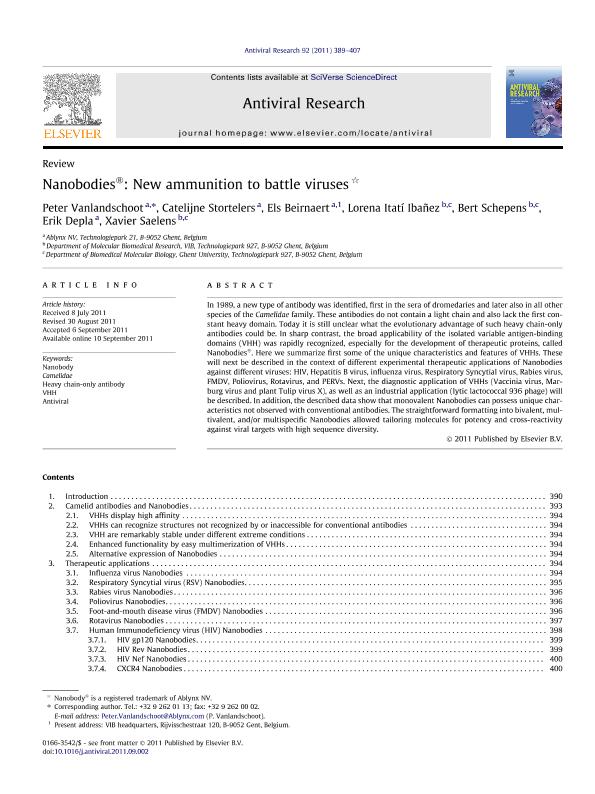Mostrar el registro sencillo del ítem
dc.contributor.author
Vanlandschoot, Peter
dc.contributor.author
Stortelers, Catelijne
dc.contributor.author
Beirnaert, Els
dc.contributor.author
Ibañez, Lorena Itatí

dc.contributor.author
Schepens, Bert
dc.contributor.author
Depla, Erik
dc.contributor.author
Saelens, Xavier
dc.date.available
2023-04-18T12:55:36Z
dc.date.issued
2011-12
dc.identifier.citation
Vanlandschoot, Peter; Stortelers, Catelijne; Beirnaert, Els; Ibañez, Lorena Itatí; Schepens, Bert; et al.; Nanobodies®: new ammunition to battle viruses.; Elsevier Science; Antiviral Research; 92; 3; 12-2011; 389-407
dc.identifier.issn
0166-3542
dc.identifier.uri
http://hdl.handle.net/11336/194326
dc.description.abstract
In 1989, a new type of antibody was identified, first in the sera of dromedaries and later also in all other species of the Camelidae family. These antibodies do not contain a light chain and also lack the first constant heavy domain. Today it is still unclear what the evolutionary advantage of such heavy chain-only antibodies could be. In sharp contrast, the broad applicability of the isolated variable antigen-binding domains (VHH) was rapidly recognized, especially for the development of therapeutic proteins, called Nanobodies¯. Here we summarize first some of the unique characteristics and features of VHHs. These will next be described in the context of different experimental therapeutic applications of Nanobodies against different viruses: HIV, Hepatitis B virus, influenza virus, Respiratory Syncytial virus, Rabies virus, FMDV, Poliovirus, Rotavirus, and PERVs. Next, the diagnostic application of VHHs (Vaccinia virus, Marburg virus and plant Tulip virus X), as well as an industrial application (lytic lactococcal 936 phage) will be described. In addition, the described data show that monovalent Nanobodies can possess unique characteristics not observed with conventional antibodies. The straightforward formatting into bivalent, multivalent, and/or multispecific Nanobodies allowed tailoring molecules for potency and cross-reactivity against viral targets with high sequence diversity.
dc.format
application/pdf
dc.language.iso
eng
dc.publisher
Elsevier Science

dc.rights
info:eu-repo/semantics/openAccess
dc.rights.uri
https://creativecommons.org/licenses/by-nc-sa/2.5/ar/
dc.subject
ANTIVIRAL
dc.subject
CAMELIDAE
dc.subject
HEAVY CHAIN-ONLY ANTIBODY
dc.subject
NANOBODY
dc.subject
VHH
dc.subject.classification
Virología

dc.subject.classification
Ciencias Biológicas

dc.subject.classification
CIENCIAS NATURALES Y EXACTAS

dc.subject.classification
Otras Nanotecnología

dc.subject.classification
Nanotecnología

dc.subject.classification
INGENIERÍAS Y TECNOLOGÍAS

dc.title
Nanobodies®: new ammunition to battle viruses.
dc.type
info:eu-repo/semantics/article
dc.type
info:ar-repo/semantics/artículo
dc.type
info:eu-repo/semantics/publishedVersion
dc.date.updated
2023-04-17T13:49:15Z
dc.journal.volume
92
dc.journal.number
3
dc.journal.pagination
389-407
dc.journal.pais
Países Bajos

dc.journal.ciudad
Amsterdam
dc.description.fil
Fil: Vanlandschoot, Peter. No especifíca;
dc.description.fil
Fil: Stortelers, Catelijne. No especifíca;
dc.description.fil
Fil: Beirnaert, Els. No especifíca;
dc.description.fil
Fil: Ibañez, Lorena Itatí. University of Ghent; Bélgica. Consejo Nacional de Investigaciones Científicas y Técnicas; Argentina
dc.description.fil
Fil: Schepens, Bert. University of Ghent; Bélgica
dc.description.fil
Fil: Depla, Erik. No especifíca;
dc.description.fil
Fil: Saelens, Xavier. University of Ghent; Bélgica
dc.journal.title
Antiviral Research

dc.relation.alternativeid
info:eu-repo/semantics/altIdentifier/doi/http://dx.doi.org/10.1016/j.antiviral.2011.09.002
dc.relation.alternativeid
info:eu-repo/semantics/altIdentifier/url/https://www.sciencedirect.com/science/article/pii/S0166354211004402
Archivos asociados
